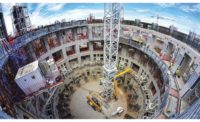Perhaps the most expensive projects on the drawing board are LNG export terminals, which super-cool natural gas into LNG form and load it for shipment overseas. "There are six brownfield LNG liquefaction projects—Sabine Pass, Freeport, Lake Charles, Cove Point, Cameron, Elba Island—that have been able to secure contracts for most of their proposed production" from foreign buyers, says Javier Diaz, senior energy analyst at Bentek Energy. (Bentek, like ENR, is part of McGraw Hill Financial.)
"The aggregated [capital expenditures] for these six projects total $46 billion," Diaz says, adding that the first four projects already have obtained approval from the Dept. of Energy to export LNG to countries that do not hold a free-trade agreement with the U.S.
"In addition to those, two greenfield projects—Corpus Christi and Magnolia LNG—also have been able to secure [memoranda of understanding] with buyers, potentially adding another $14.1 billion of LNG liquefaction projects to be built in the U.S. during the 2016-19 period," Diaz says.
Jennifer Van Dinter, manager of NGL analysis and consulting services at Bentek, says the fact that so much construction will be occurring in 2016-17 "will make the first-mover advantage important. Those projects that secure skilled crafts-people, equipment and supplies first will likely avoid cost overruns and meet announced time lines," Van Dinter says, adding, "Many of the other projects will likely advance but may experience delays or capital-cost escalation."
Bob Nussmeier, vice president for strategic clients and partners at Kiewit Oil, Gas & Chemical North America, agrees. Most of major projects now on the drawing board will advance, he says, "but many will have their start dates pushed back a year or so due to delays in permitting and engineering.
"The projects that need to get third-party financing are at greatest risk, as most lenders require [lump-sum turnkey] pricing, and that is harder to get to today with the price of labor and materials going up at an unknown rate," Nussmeier says.
The skilled craftspeople needed for major jobs "will be attainable," he adds, but questions remain about the experience and ability of those workers and about how much their pay levels will be driven up among contractors competing for their services.
Keith Manning, executive vice president at Zachry Holdings Inc., says he, too, is optimistic that "many of the major projects will go forward on the back of the tremendous deal-creation power of shale gas." Zachry is working on several big jobs, he says, including the Freeport LNG project; a Conoco Phillips Chemical derivatives project in Sweeney, Texas; and "a large, multi-product export terminal along the Gulf Coast. We also are very busy with proposals."
Manning acknowledges Zachry executives "are concerned about craft availability on the Gulf Coast, but we feel comfortable that, due to our strong direct-hire model, we will be able to staff our projects. We do expect [cost] escalation, particularly on labor, to be quite high, likely double digit, year over year."
Bentek's Diaz says any labor and equipment challenges faced by the contractors building LNG export terminals in the U.S. will pale compared to those facing contractors overseas.


Post a comment to this article
Report Abusive Comment